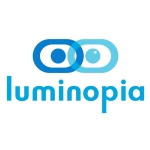
Luminopia One, a Digital Therapeutic for Amblyopia, Demonstrates Safety and Efficacy in Phase 3 Pivotal Trial
Positive Phase 3 data published in Ophthalmology show clinically meaningful vision improvement in children with amblyopia, commonly referred to as lazy eye
Investigational digital therapeutic allows children to watch TV as treatment for leading cause of vision loss in children
CAMBRIDGE, Mass.–(BUSINESS WIRE)–Luminopia today announced the publication of positive Phase 3 pivotal data of its investigational treatment for amblyopia—Luminopia OneTM—in OphthalmologyⓇ, the journal of the American Academy of Ophthalmology. This is the first successful randomized controlled trial of a novel amblyopia treatment in more than a decade, and the results provide strong evidence supporting a potential new therapy for millions of patients. Unlike current treatment options, which can be frustrating and stigmatizing for young children, Luminopia One is an investigational digital therapeutic that allows patients to watch visually modified TV shows and movies to improve their vision.
In this pivotal study, conducted at 21 leading academic and community sites in the U.S., children in the treatment group, who received Luminopia One plus glasses, experienced a statistically significant improvement in Best Corrected Visual Acuity (BCVA; the primary endpoint) compared to those in the control group, who wore glasses alone (difference between groups: 1.0-line, p=0.0011). No serious adverse events were reported. The results are being evaluated by the U.S. Food and Drug Administration (FDA) for de novo premarket approval.
“The data from this pivotal trial validate Luminopia One as a safe and effective potential new treatment option for amblyopia in young children,” said Robert Langer, Sc.D., an Institute Professor at Massachusetts Institute of Technology (MIT), co-founder of Moderna, co-author of the publication and Luminopia Board Director. “These positive data also illustrate the potential of digital therapeutics as a new class of treatments for serious diseases.”
Amblyopia, commonly referred to as lazy eye, is a condition characterized by neurological deficits in the visual cortex which result in uncorrectable vision deficits. Affecting 3% of all children, amblyopia is typically treated with corrective glasses combined with eye patching or atropine eye drops that prevent usage of the stronger eye and force usage of the weaker eye.1 Current treatment options are limited to monocular approaches, which do not train the eyes to work together and are not sufficient in many cases to restore full visual function.2 Adherence to current treatment options is also a significant challenge, as parents struggle to convince young children to wear a patch for many hours each day, or take eye drops that blur their stronger eye.
Luminopia One, developed in collaboration with leaders from Boston Children’s Hospital and the Picower Institute for Learning and Memory at MIT, is designed to allow children to watch TV shows and movies as treatment. With Luminopia One, patients choose video content they want to watch, and a software application modifies the content in real-time to rebalance visual input to the brain. This unique, binocular approach promotes weaker eye usage and encourages patients’ brains to combine input from both eyes, unlike monocular therapies like patching and atropine.
Luminopia has partnered with leading media companies to offer popular, engaging and educational content for children, from familiar names like Sesame Workshop and Nelvana. Treatment is delivered using commercially available virtual reality (VR) headsets. Upon potential approval by the FDA, Luminopia One will be prescribed by an eye care professional for 1 hour per day, 6 days per week for 12 weeks, and continued treatment may be prescribed depending on each patient’s response to treatment.
“Luminopia’s efforts to rethink treatment for children with amblyopia are very promising. Patching is often ineffective due to poor adherence, as any parent who has tried to patch their child’s eye knows. In addition, current treatment options don’t encourage patients to use both eyes together. Luminopia One addresses both of these problems,” said Gil Binenbaum, M.D., MSCE, pediatric ophthalmologist, and advisor to Luminopia. “It is exciting to envision a future where clinicians will be able to prescribe entertaining and educational shows instead of patching to improve children’s vision.”
Luminopia One Amblyopia Vision Improvement Study Design and Results
The published study was a Phase 3 multicenter, randomized controlled clinical trial designed to evaluate the safety and efficacy of Luminopia One to treat amblyopia in children aged 4-7. The primary endpoint in the study was improvement in BCVA on a logMAR eye chart in the weak eye from baseline to the 12-week visit. Study participants were randomized 1:1 to the treatment group, which received Luminopia One plus glasses, and to the control group, which received glasses alone. The study was designed with input from the FDA, and the study data have been submitted to the FDA to support de novo approval of Luminopia One.
Participants were recruited at 21 academic and community sites in the U.S., including the Cleveland Clinic, UCLA Jules Stein Eye Institute, Duke Eye Center, Ann & Robert H. Lurie Children’s Hospital of Chicago, Texas Children’s Hospital, and Children’s Hospital of Philadelphia. A total of 105 patients were enrolled in the study—51 were randomized to the treatment group and 54 to the control group. An interim analysis was planned and conducted after 105 participants had completed the primary endpoint visit at 12 weeks. At the interim analysis, the difference between groups in weak eye BCVA improvement was significant (1.0-line, p=0.0011, 96.14% CI: 0.33-1.63 lines). No serious adverse events were reported.
The study showed:
- 1.8-line improvement in BCVA in the weak eye, from baseline to the 12-week visit (95% CI: 1.4-2.3 lines, N=45) in the treatment group
- 0.8-line improvement (95% CI: 0.4-1.3 lines, N=45) in the control group
- Proportion of participants who improved 2 lines or more in BCVA in the weak eye, from baseline to the 12-week visit, was greater in the treatment group (62%) compared to the control group (33%, p=0.006).
- 84% of participants in the treatment group had a history of patching or atropine treatment, but the efficacy of Luminopia One remained robust in this subgroup (difference between groups: 1.0-line, p=0.005).
The study also evaluated adherence and patient satisfaction, as these are challenges with current amblyopia treatments. The median adherence for Luminopia One in the study was 88%, substantially higher than studies have shown for patching.3 Patient satisfaction was evaluated using the Net Promoter Score (NPS) metric, and Luminopia One’s NPS was +65, comparable to popular consumer products like the iPhone.4
“This study is the first randomized controlled trial to demonstrate efficacy of a novel, binocular approach for treating this neuro-visual condition in children,” said Scott Xiao, Luminopia CEO. “We are excited about the potential to provide a new treatment option for millions of children with amblyopia around the world. We are also proud to be redefining what it means to receive treatment, by developing a product that allows patients to watch TV as therapy.”
A link to the publication, “Randomized Controlled Trial of a Dichoptic Digital Therapeutic for Amblyopia,” can be found here: https://www.aaojournal.org/article/S0161-6420(21)00682-5/fulltext.
About Luminopia One
Luminopia One is an investigational digital therapeutic intended as a treatment for amblyopia that is currently under review by the FDA for de novo approval. With Luminopia One, patients watch visually modified TV shows and movies as treatment. Therapeutic algorithms are applied in real-time to patient-selected video content to promote weaker eye usage and encourage patients’ brains to combine input from both eyes, and treatment is delivered using commercially available virtual reality (VR) headsets. Upon a potential positive decision from the FDA, Luminopia One will be the first approved digital therapeutic for a neuro-visual disorder.
Luminopia One has been validated in multiple clinical trials, including a Phase 3 pivotal trial that demonstrated its safety and efficacy in children aged 4-7 for the treatment of amblyopia. Pilot studies have also shown an efficacy signal in older children and adolescents.
About Amblyopia5
Amblyopia, commonly referred to as lazy eye, is a medical condition characterized by reduced vision that cannot be explained by structural ocular or optic nerve abnormalities alone. Often diagnosed in young children, amblyopia is driven by neurological deficits which suppress the visual input from the weaker eye, leading to long-term deficits in vision. Amblyopia can be caused by a variety of different factors, including a refractive error such as nearsightedness (myopia), farsightedness (hyperopia), or astigmatism; strabismus, which is when one eye drifts; or rarely, cataracts, or cloudiness in the lens. Amblyopia is the most common cause of vision loss in children and affects 3% of children worldwide.
About Luminopia
Luminopia is pioneering a new class of treatments for significant neuro-visual disorders. Luminopia is committed to creating digital therapeutics that are both rigorously evaluated for FDA approval and genuinely engaging for patients. As an Innovation Partner of Boston Children’s Hospital*, the company is developing its lead product, Luminopia One, to treat amblyopia, the leading cause of vision loss among children. For more information, visit luminopia.com.
*Boston’s Children’s Hospital holds equity in Luminopia. David Hunter, M.D., Ph.D., Ophthalmologist-in-Chief at Boston Children’s Hospital is an advisor to Luminopia and holds equity.
1https://www.nei.nih.gov/learn-about-eye-health/eye-conditions-and-diseases/amblyopia-lazy-eye
2https://www.ncbi.nlm.nih.gov/pmc/articles/PMC5587672/
3https://iovs.arvojournals.org/article.aspx?articleid=2127884
4https://customer.guru/net-promoter-score/apple-iphone
5https://www.nei.nih.gov/learn-about-eye-health/eye-conditions-and-diseases/amblyopia-lazy-eye
Contacts
Jenna Mathis
Health+Commerce
jennamathis@healthandcommerce.com
610.751.3985
